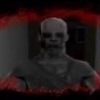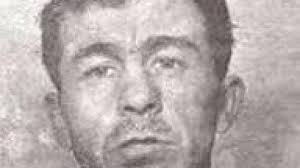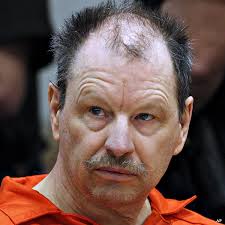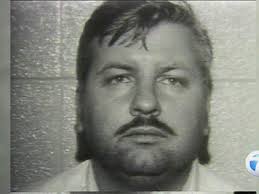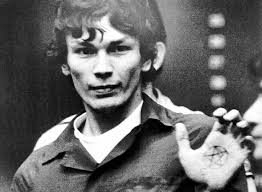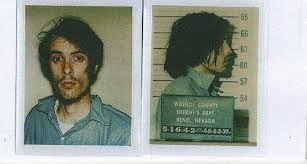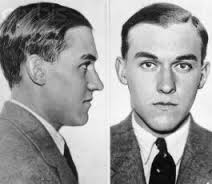On March 13, 1933, Donald Gaskins was born in Florence County, South Carolina. At a young age, Gaskins was teased and given the nickname “Pee Wee” as a result of his small body frame. Violence and ridicule followed him from his home where his stepfather beat him to his school where he fought with the other kids daily. This would ultimately lead to him becoming the most prolific serial killer in South Carolina.
At age 11, Gaskins quit school and began working on cars at a local garage. While working there, he met two boys, Danny and Marsh. They were all around the same age and out of school, so they teamed up and called themselves “The Trouble Trio.” The trio burglarized homes, picked up prostitutes, and even sometimes raped little boys. They would threaten the little boys so they wouldn’t go to the police. Eventually the trio broke up after they were caught for gang-raping Marsh’s little sister. For punishment, the parents beat the boys until they bled. Danny and Marsh left the area shortly after that. Gaskins continued to burglarize homes alone. In 1946, a girl who knew Gaskins interrupted him while he was burglarizing her home. She struck him with an ax. He managed to get it away from her, struck her in the head and arm with it before fleeing the scene. Luckily, the girl survived the attack. Gaskins was arrested and convicted for assault with a deadly weapon and intent to kill. During the court proceedings, it was the first time he had heard his real name spoken in his whole life. He was sent to the South Carolina Industrial School for Boys until he turned 18.
At the reform school, Gaskins was almost immediately attacked and raped due to his small stature. He spent his time either accepting protection from the “Boss-Boy” in exchange for sex or attempting to escape. Eventually he escaped from the reform school and got on with a traveling carnival. He married a 13-year-old girl while there, but decided to return to the reform school to finish out his sentence. After he was released from reform school, he began working on a tobacco farm. There, he got involved in insurance fraud; he worked with a partner by collaborating with local tobacco farmers to burn their barns for a fee. Around the area, people began to wonder about Gaskins’ involvement with the barn fires. When his employer’s daughter questioned him about the barn fires, he panicked and split the girl’s skull with the hammer in hand. He received a five year sentence in prison for assault with a deadly weapon and attempted murder. While in prison, Gaskins committed his first murder in an attempt to become a “Power Man.” Power men are the most brutal and feared inmates. Gaskins decided killing a fellow inmate would be enough to keep the other inmates from bothering him. He was found guilty of manslaughter and sentenced to six months of solitary confinement but he accomplished his goal of becoming a “Power Man.” The newly found status made his life in prison more enjoyable.
In 1955, his wife filed for divorce. Gaskins flipped and escaped from prison. Shortly thereafter, he remarried but the second marriage only lasted two weeks. Then he became involved with Betty Gates. The two went to Tennessee to bail out Gates’ brother, but when Gaskins arrived back at the hotel he was in for a surprise. He found out Gates’ brother was actually her husband and he had recently escaped. The police arrived at the hotel and it didn’t take them long to realize that he was an escaped convict. He was sent back to prison with an extra nine months for aiding the escape of a prisoner. In August 1961, he was released from prison and returned to South Carolina. He was unable to stay out of trouble and began burglarizing homes again. He avoided arrest by working with a traveling minister as his driver and general assistant. This was an easy way Gaskins could travel from town to town while burglarizing homes and would make his crimes harder to trace.
In 1962, Gaskins was arrested for the statutory rape of a 12-year-old girl, but he escaped to North Carolina in a stolen car. Once in North Carolina, he met a 17-year-old girl whom he married. She eventually turned him into the police for statutory rape and he received six years in Columbia Penitentiary. In November 1968, he was paroled and made a vow to never return again. Throughout Gaskins’ life, he described feelings that forced him into criminal activity which he referred to as “them aggravated and bothersome feelings.” In September 1969, he found relief from these feelings. Gaskins picked up a female hitchhiker in North Carolina and became angry when she laughed at his sexual propositions. He beat her until she was unconscious. Gaskins raped, sodomized, and tortured her. Then he went to a swamp to sink her weighted body so she would drown.
His “process” of rape, torture, and murder was described by Gaskins as a “vision” into the “bothersome feelings” he experienced throughout his life. Satisfying these feelings became his driving force in life. He mastered the skill of torture, often keeping his injured victims alive for days. Sometimes he would cannibalize their severed body parts and either make them watch him eat them in horror or join in the eating. Gaskins preferred female victims, but that didn’t stop him from doing the same to the males he happened upon. By 1975, he had found 80 boys and girls along the highways in North Carolina and killed them. He considered these highway murders as “weekend recreation” and thought killing his personal acquaintances were “serious murders.” Some of the serious murders included his 15-year-old niece and her friend. He lured the two girls off to an abandoned house where he beat, raped, and drowned them. Although Gaskins had a reputation for being explosive, some people in the town just thought he was mentally disturbed. Most tried to avoid even being around him, but some people actually liked him and considered him as their friend. One of the people who considered Gaskins to be a friend was Doreen Dempsey, a mother of a two-year-old baby girl and was pregnant with her second child at the time of her death. She was leaving town and decided to get a ride to the bus station from her old friend. Gaskins took her to a wooded area where he raped and killed her and then raped, sodomized, and killed her baby. He buried the two together.
Gaskins was 42 years old in 1975 and had been killing steadily for the past 6 years. Up until then, he had worked alone and that had helped him avoid being caught. However after he murdered three people after their van broke down on the highway, he needed some help. He called up an ex-con Walter Neely to drive the victims’ van to his garage so he could repaint it and sell it. Gaskins was also a hired hit man. That same year, Suzanne Kipper, paid him $1500 to kill her ex-boyfriend, Silas Yates. John Powell and John Owens handled the communication between Gaskins and Kipper concerning the arrangement of the murder. On February 12, 1975, Diane Neely lured him out of the house by claiming to have car trouble. Gaskins then kidnapped and murdered Yates while Powell and Owens watched. All three helped bury him. Diane Neely and her boyfriend decided to blackmail Gaskins. They asked for $5000 in hush money; Gaskins quickly got rid of them after he arranged a meeting for the payoff. Around the same time, Gaskins had tortured and killed other people he knew, such as Kim Ghelkins, a 13-year-old who rejected him. Two locals robbed Gaskins’ repair shop without knowing about his bad side. He eventually killed and buried these two with the other locals in his private cemetery. Once again, he called on Walter Neely to help him bury the two bodies. While there, Gaskins even showed Neely where he had buried other locals.
After the disappearance of Kim Ghelkins, the authorities began to become suspicious of Gaskins. After searching his apartment, they found clothing that had been worn by Ghelkins. Gaskins was indicted for “contributing to the delinquency of a minor.” Neely cracked under pressure while waiting for the trial and showed the police Gaskins’ private cemetery. In the cemetery, they found the bodies of the following: Sellars, Judy, Howard, Diane Neely, Johnny Knight, Dennis Bellamy, Doreen Dempsey and her child. On April 27, 1976, Gaskins and Walter Neely were charged with eight counts of murder. On May 24, 1976, a jury convicted Gaskins of the murder of Dennis Bellamy and he was sentenced to death. In an attempt to avoid additional death sentences, he later confessed to seven more murders. In November 1976, the Supreme Court ruled that the death penalty was unconstitutional, so his death sentence was converted to life with seven consecutive life sentences. In 1978, the death penalty was restored. This didn’t mean anything to Gaskins until he was caught and found guilty for being paid to murder fellow prisoner, Rudolph Tyner. This conviction caused him to receive a death sentence.
He began confessing for other murders to avoid the electric chair. If these confessions were true, then he would be the worst killer in South Carolina’s history. He admitted to the murder of Peggy Cuttino but prosecutors had already charged and sentenced William Pierce to life in prison for the murder. Gaskins’ confession was rejected. Over the last months of his life, Gaskins worked with author Wilton Earl on his book, Final Truth. This book was published in 1993 and discussed the murders and the “bothersome” feelings Gaskins felt throughout his life. On the day of his execution, he cut his wrists in a last attempt to avoid the electric chair. However that didn’t work. Gaskins was placed in the electric chair, with stitched arms, and pronounced dead by electrocution on September 6, 1991. It is unknown as to how many murders Gaskins actually committed since information was never provided for all of the bodies. Maybe he just wanted to be known as the most prolific serial killer in South Carolina. One thing we know for certain is that Donald Gaskins was a psychopath who had no regard for human life.
Gary Leon Ridgway is famous for being the serial killer who has admitted to more murders than anyone else. He is linked to the deaths of 48 young women, most of who were strangled to death around the Seattle and Tacoma, Washington areas. It took nearly 20 years for Ridgway to be caught and brought to justice. He committed the majority of his murders between 1982 and 1983, during which time the bodies of many of his victims were found near Green River in Washington. This earned the then unknown assailant the title of “the Green River Killer.” Police officers discovered the bodies of many of Ridgeway’s victims naked along the river bank. They were often placed together in groups, and sometimes the bodies were even posed. Almost all of the victims were prostitutes, so the police were able to identify a common trait that the killer looked for and used that information in their ongoing investigation. The sheriff’s department founded the “Green River Task Force” and assigned the men involved with the responsibility of tracking down the serial killer.
In 1982, Gary Ridgway was arrested on a prostitution charge. He became a suspect in the killings, but after passing a polygraph test in which he claimed to be innocent, he was no longer considered to be a prime candidate. Members of the task force held on to their suspicions and to samples of his hair and saliva. After 1983, the murders seemed to have stopped but the search continued for the killer. By 2001, investigators had DNA evidence of the murderer and it was compared to the strands Ridgway’s hair still in police custody. The samples matched. Ridgway was arrested on November 30, 2001 after being linked to the murder of four women. During the trial that followed in 2003, Ridgway plead guilty to the murders of 48 women. He claimed that there were more victims – as many as 90 in total. To avoid the death penalty, he agreed to help police officials locate the remains of his victims that had not yet been discovered. Ridgway was sentenced to 48 consecutive prison sentences. He currently resides at the Washington State Penitentiary and has no hope of parole.
In 1861, Herman Webster Mudgett was born in New Hampshire. It is said that at an early age he was fascinated with skeletons and soon became obsessed with death. It may have been this interest that led him to pursue medicine. After graduating high school at 16, Mudgett changed his name to Henry Howard Holmes, and later in life would be known as H.H. Holmes. Holmes studied medicine at a small school in Vermont before being accepted into the University of Michigan Medical School. While enrolled in medical school, Holmes stole cadavers from the laboratory, burned or disfigured them, and then planted the bodies making it look as if they had been killed in an accident. The scandal behind it was that Holmes would take out insurance policies on these people before planting the bodies and would collect money once the bodies were discovered.
In 1884 Holmes passed his medical exams and in 1885 he moved to Chicago where he got a job working at a pharmacy under the alias Dr. Henry H. Holmes. When the owner of the drugstore passed away, he left his wife to take over the responsibilities of the store; however, Holmes convinced the widow to let him buy the store. The widow soon went missing and was never seen again. Holmes claimed that she moved to California, but this could never be verified. After Holmes had become the owner of the drugstore, he purchased an empty lot across the street. He designed and built a 3-story hotel, which the neighborhood called the “Castle.” During its 1889 construction, Holmes hired and fired several construction crews so that no one would have a clear idea of what he was doing; he was designing a “Murder Castle.” After construction was complete in 1891, Holmes placed ads in newspapers offering jobs for young women and advertised the Castle as a place of lodging. He also placed ads presenting himself as a wealthy man looking for a wife.
All of Holmes’ employees, hotel guests, fiancés, and wives were required to have life insurance policies. Holmes paid the premiums as long as they listed him as the beneficiary. Most of his fiancés and wives would suddenly disappear, as did many of his employees and guests. People in the neighborhood eventually reported that they saw many women enter the Castle, but would never see them exit. In 1893, Chicago was given the honor of hosting the World’s Fair, a cultural and social event to celebrate the 400th anniversary of Columbus’ discovery of America. The event was scheduled from May to October, and attracted millions of people from all over the world. When Holmes heard that the World’s Fair was coming to Chicago, he looked at it as an opportunity. He knew many visitors would be searching for lodging near the fair and believed many of them would be women whom he could easily seduce into staying at his hotel. After being lured into the hotel, many of these out-of-town visitors would never be seen again.
The first floor of the Castle had several stores; the two upper levels contained Holmes’ office and over 100 rooms that were used as living quarters. Some of these rooms were soundproof and contained gas lines so that Holmes could asphyxiate his guests whenever he felt like it. Throughout the building, there were trap doors, peepholes, stairways that led nowhere, and chutes that led into the basement. The basement was designed as Holmes’ own lab; it had a dissecting table, stretching rack, and crematory. Sometimes he would send the bodies down the chute, dissect them, strip them of the flesh and sell them as human skeleton models to medical schools. In other cases, he would choose to cremate or place the bodies into pits of acids. Through it all, Holmes travelled throughout the U.S. committing insurance scams with his accomplice, Benjamin Pitezel. Once the World’s Fair had ended, Chicago’s economy was in a slump; therefore, Holmes abandoned the Castle and focused on insurance scams – committing random murders along the way. During this time, Holmes stole horses from Texas, shipped them to St. Louis, and sold them – making a fortune. He was arrested for this swindle and sent to jail.
While in jail, he concocted a new insurance scam with his cellmate, Marion Hedgepeth. Holmes said he would take out an insurance policy for $10,000, fake his own death, and then provide Hedgepeth with $500 in exchange for a lawyer who could help him if any problems arose. Once Holmes was released from jail on bail, he attempted his plan; however, the insurance company was suspicious and did not pay him. Holmes then decided to attempt a similar plan in Philadelphia. This time he would have Pitezel fake his own death; however, during this scam Holmes actually killed Pitezel and collected the money for himself. In 1894, Marion Hedgepath, who was angry that he did not receive any money in the initial scam, told police about the scam Holmes had planned. The police tracked Holmes, finally catching up to him in Boston where they arrested him and held him on an outstanding warrant for the Texas horse swindle. At the time of his arrest, Holmes appeared as if he was prepared to flee the country and police became suspicious of him. Chicago police investigated Holmes’ Castle where they discovered his strange and efficient methods for committing tortuous murders. Many of the bodies they located were so badly dismembered and decomposed that it was hard for them to determine exactly how many bodies there really were.
The police investigation spread through Chicago, Indianapolis, and Toronto. While conducting their investigation in Toronto, police discovered the bodies of the Pitezel children, who had gone missing sometime during Holmes’ insurance fraud spree. Linking Holmes to their murders, police arrested him and he was convicted of their murders. He also confessed to 28 other murders; however, through investigations and missing person’s reports, it is believe that Holmes is responsible for up to 200 murders. In May 1896, one of America’s first serial killers, H.H. Holmes, was hanged. The Castle was remodeled as an attraction and named the “Holmes Horror Castle”; however, it was burned to the ground shortly before its opening.
Jeffrey Dahmer, an American serial killer and sex offender, was born on May 21, 1960. Between the years of 1978 and 1991, Dahmer murdered 17 males. Rape, dismemberment, necrophilia, and cannibalism were involved in his murders. He was beaten to death on November 28, 1994 by an inmate at the Columbia Correctional Institution, where he had been incarcerated.
By most accounts Dahmer had a normal childhood; however he became withdrawn and uncommunicative as he got older. He began showing little to no interest in hobbies or social interaction around the ages of 10 to 15. Dead animals became an interest of his and he also started drinking heavily during his high school years. His drinking escalated and was a huge issue following high school. His father made him enlist in the army, but he was kicked out due to alcoholism. Dahmer then traveled to Florida, spending most of his time in the hospital, but was eventually kicked out for his drinking. His behavior became increasingly strange once he moved in with his grandmother. She began finding disturbing things in her home, including a .357 magnum under his bed and a male mannequin in his closet. He continued his fascination with dead animals, dissecting dead squirrels in the basement and dissolving them with chemicals. In both 1982 and 1986, he was arrested for indecent exposure. The strange behaviors led his grandmother to ask him to move out in the summer of 1988.
Once he moved out of his grandmother’s, he found an apartment close to his job at the Ambrosia Chocolate Factory. Only one day after moving into his new apartment, he was arrested for drugging and sexually fondling a 13-year-old boy. He was given a sentence of five years of probation, one year at a work release camp, and required to register as a sex offender. He was released two months early from the work release camp and soon moved into a new apartment. Shortly following, the string of murders began and ended with his arrest in 1991. His first murder was in the summer of 1978. Dahmer was 18-years-old. After being left alone by his father who was away on business, he picked up a hitch hiker named Steven Hicks and offered to take him back to his father’s house to drink beer. When Hicks decided to leave, Dahmer hit him in the back of the head with a 10 lb dumbbell. He then buried the body in the back yard, and admitted to killing him because he didn’t want him to leave. Nine years passed before he killed again. Steven Tuomi was the second victim, killed in September of 1987. Dahmer picked him up from a bar and later killed him on impulse. He stated that he had no memory of committing that crime. The killings occurred sporadically after Tuomi, with two in 1988 and one in 1989. He usually picked up his victims at gay bars and had sex with them before killing them. Until he was caught, he even kept the skull of one of his victims, Anthony Sears. In May of 1990, he once again moved out of his grandmother’s house into an apartment that would later be the location of four more murders in 1990 and three in 1991.
In 1991, a boy was discovered wandering the streets drugged and confused, he was 14-year-old Konerak Sinthasomphone. The two women that found him called 911; however Dahmer chased after his victim and stated to the police that he was his 19-year-old boyfriend. Without a sex offender background check or age verification, the police handed Sinthasomphone back over to Dahmer. Later that same night, Dahmer killed and dismembered Sinthasomphone and kept his skull as a souvenir. He began killing around one person each week by the summer of 1991. Dahmer was using the idea that he could turn his victims into “zombies” to have youthful submissive sexual partners. He used many different techniques, such as drilling holes into their skull and injecting hydrochloric acid or boiling water into their brains. Soon, residents of Oxford Apartments complex began noticing awful smells coming from Dahmer’s apartment, as well as loud noises from falling objects. Although most serial killers stick with one racial background, Dahmer killed a variety of people from different racial backgrounds.
On the day of his arrest, Dahmer attempted to lure Tracy Edwards into his home. While inside the home, Edwards was forced into the bedroom by Dahmer with a butcher knife. During the struggle, Edwards was able to get free and escape out into the streets where he flagged down a police car. When the police arrived at Dahmer’s apartment, Edwards alerted them to the knife that was in the bedroom. Upon entering the bedroom pictures of dead bodies and dismembered limbs allowed the officers to arrest Dahmer. Further investigation of the home lead to a severed head in the refrigerator, three more severed heads in the apartment, multiple photographs of victims and human remains and more human remains in his refrigerator. It was later assumed that he practiced necrophilia and cannibalism. A total of seven skulls were found in his apartment as well as a human heart in the freezer. An attempted alter was also constructed with candles and human skulls in his closet.
After being indicted on 17 murder charges, the trial began on January 30, 1992. Even though the evidence against him was overwhelming, Dahmer pleaded not guilty by reason of insanity. Following two weeks of trial, the court declared him sane and guilty on 15 counts of murder. He was sentenced to 15 life terms, for a total of 957 years in prison. Following sentencing, Dahmer expressed remorse for his actions and wished for his own death. In May of the same year, he entered a guilty plea for the murder of his first victim, Stephen Hicks. During his time in prison, Dahmer declared himself a born-again Christian. He served his time at the Columbia Correctional Institution in Portage, Wisconsin. He was attacked twice during that time. The first attempt, to slice his neck with a razor, left him with only superficial wounds. However, the second attack ended up killing him, and he died on the way to the hospital from severe head trauma.
John Wayne Gacy was a friendly man who loved to entertain young children. He frequently dressed up as his alter ego, Pogo the Clown, at parties that he hosted for his entire neighborhood. By 1978, public perception of Gacy would change forever, and he would earn the ominous nickname of “the Killer Clown”. The first warning sign about Gacy appeared in 1964, when he was found guilty of sodomizing two young boys. Gacy was arrested and spent 18 months in prison. By the time he was released, Gacy was divorced and decided to move to Chicago for a fresh start.
In Chicago, Gacy founded a successful construction business, attended church, re-married, and volunteered as the Democratic Precinct Captain in his area. During this time he threw elaborate block parties and built a solid reputation in his community. Gacy was respected and admired by friends, neighbors, and police officers. During July of 1975, a teenager who worked for Gacy disappeared. His parent’s pleaded with Chicago police officers to investigate Gacy, but they never did. This would not be the last time worried parents asked officials to review Gacy as a suspect, but the pleas fell on deaf ears. In 1976, Gacy divorced for a second time, and it seemed to give him a feeling of personal freedom. Unknown to anyone else at the time, Gacy began to rape and kill young men. Over a period of just a few years, he murdered 33 people, 29 of whom were found underneath Gacy’s house — 26 in the crawlspace and 3 other bodies were found in other areas beneath his home.
A young man went to the Chicago police for help in 1977, claiming that he had been kidnapped and molested by John Wayne Gacy. A report was made, but officers failed to follow up on it. The following year, Gacy murdered a 15-year-old boy who had gone to Gacy’s home to ask about a job with his construction company. This time, the Des Plaines police got involved and searched Gacy’s home. They found a class ring, clothing for much smaller individuals, and other suspicious items. Upon further investigation, officers discovered that the ring belonged to a teenage boy who was missing, and they found a witness who claimed Gacy had admitted to killing up to 30 people. Gacy was arrested, and used an insanity plea in the hopes of a not guilty verdict. The ruse did not work, and he was found guilty. On May 10, 1994, John Wayne Gacy was executed by lethal injection.
Richard Ramirez, known as the “Night Stalker” was an American serial killer. Ramirez spent over two years of his life raping and torturing over 25 victims and killing more than a dozen people. Most of these crimes were committed in the victims California homes. Richard, the son of Mercedes and Julian Ramirez, was born in El Paso, Texas on February 28, 1960. Growing up Richard was a troubled kid. A lot of this was due to his older cousin, Mike, who had just returned from fighting in Vietnam. Ramirez’s cousin would tell him gruesome stories and show pictures of the torture he would inflict upon Vietnamese women. Mike introduced drugs to Ramirez, which consequently resulted in Ramirez committing petty crimes. He also became a Satan worshiper. Because of this rebellion, Ramirez became alienated from his parents.
The first series crime that Ramirez was involved in was the murder of his cousin’s wife. Although Mike was the one whom murdered his own wife, Ramirez was at the scene of the crime and didn’t do anything to stop it. In 1977, Ramirez was sent to a juvenile detention center for a series of petty crimes. In addition, he was put on probation for marijuana possession in 1982. Soon after these two crimes, Ramirez moved to California and continued to commit crimes such as burglary and possession of cocaine, as well as a car theft charge, which resulted in a jail sentence. On June 28th 1984, Ramirez’s committed his first murder. The 79-year-old victim was sexually assaulted, stabbed and murdered in her own home. In just one year Ramirez had murdered over a dozen people and tortured of 25 people. After many delays, in 1989, Richard Ramirez, age 29, was sentenced to the conviction of 13 murders, five attempted murders, 11 sexual assaults and 14 burglaries. Ramirez was sentenced to die in California’s gas chamber. His remarks to this were “Big deal. Death always went with the territory. See you in Disneyland.” Twenty-four years after this sentence, while Ramirez had been on death row for more than 23 years, Ramirez died from B-cell lymphoma at age 53 on June 7, 2013.
Richard Trenton Chase became known as “The Vampire Killer of Sacramento” because he would drink the blood of his victims and practiced cannibalism with their body parts. Six known victims were claimed by Chase. He was born on May 23, 1950 in Sacramento, California. As a child he was known to set fires, wet the bed, and torture animals. Once he became older, he started drinking and using drugs, mostly smoking marijuana and using LSD. He was in and out of mental institutions during much of his life. He developed hypochondria from his drug and alcohol abuse which caused him to tell doctors that his pulmonary artery had been stolen, his heart would stop beating, and he claimed that his blood was turning to powder.
When he was 21, he lived on his own in an apartment. His roommates became fed up with his behavior and decided to move out, and he eventually had to return home. He didn’t stay long because his father put up rent for a new apartment. He had no social life and no girlfriends. Chase spent time capturing and killing animals, and then eating them raw or blended up. In 1976, he was hospitalized for blood poisoning after injecting himself with the blood from a rabbit he killed. Many patients and nurses were frightened by him and referred to him as Dracula. He was frequently found with blood smeared on his face which he claimed was from cutting himself shaving. However, he was actually biting the heads off birds and sucking their blood. Once he began taking medication, he was released.
A year later, Chase was found in a field near Lake Tahoe, Nevada. He was naked and covered in cow’s blood. The incident was reported but nothing else was done. Only a few short months later, Chase shot and killed Ambrose Griffin. The event was a drive-by, according to the FBI. Chase was not identified at first as the shooter. His next victim, Terry Wallin, was the 22 year-old pregnant wife of David Wallin. She was found by her husband when he arrived home from work, disemboweled and drained of her blood. It appeared that Chase had collected her blood into a yogurt cup to drink it. Again, Chase was not identified as the savage killer. An investigation began and other incidents were discovered, such as the burglary of a house nearby where the disemboweled remains of a dog were found.
The FBI developed a profile for the suspect based on the evidence; it was a perfect match for Chase. The FBI asked for any information leading to his capture but it wasn’t long before another murder was committed. A neighbor entered the home of Evelyn Miroth, only to find a massacre. Not only was 36 year-old Evelyn found dead, but her 6 year-old son Jason and family friend Daniel Meredith were also found dead. Evelyn’s 22 month old nephew, Michael Ferreira was also missing from the home. The playpen where Michael would normally be found was covered in blood and contained a pillow with a bullet hole, so it was assumed he was also killed and the suspect took the body with him when he left.
A significant lead for the police came from a woman in her 20’s who mentioned that she ran into a man she had gone to high school with and he approached her car. She noticed that his eyes were sunken, he was extremely thin, and he had blood stains on his sweatshirt. She identified him as Richard Trenton Chase. The police discovered that he resided within a mile of most of the murder sites. After staking out his apartment, police took Chase into custody. He was forcefully detained and a gun found in evidence was linked back to all of the murders. Authorities also discovered a 12-inch butcher knife, rubber boots, animal collars, three blenders containing blood, and several dishes inside the refrigerator containing body parts. A calendar was even found in his apartment containing the word “today” marked on the dates of the Wallin and Miroth murders. A mummified, decapitated, baby was then found later in a box outside of a vacant lot. It was determined to be the nephew of Evelyn Miroth.
The trials began in 1979, and Chase pleaded not guilty by reason of insanity. However, he was deemed legally sane at the time he committed the crimes and was found guilty on all six murder counts. During an interview, Chase admitted to walking the streets checking to see if doors were unlocked. He stated that, “if the door was locked that meant you weren’t welcome.” Following his conviction, he began receiving medication. Instead of actually taking the medication, he stockpiled it until he had enough to commit suicide. He was found dead in his cell in December of 1979.
In 1928, southern California was booming. Agriculture and the movie industry had transformed this area into a lively metropolis. However a string of child abductions and murders in the small town of Wineville changed the views of the city. A man named Gordon Stewart Northcott kidnapped, sexually abused and murdered at least three, and possibly up to as many as twenty, young boys. It is believed that he had the help of his mother and his Canadian nephew to commit these crimes.
On March 10, 1928, Walter Collins disappeared. This nine-year-old boy was last seen around 5 pm by a neighbor at the corner of Pasadena Avenue and North Avenue 23 in Lincoln Heights, Los Angeles. His mother, Christine Collins, gave him some money to go see a movie at a nearby theatre. His father was in Folsom State Prison for robbery. The Los Angeles Police Department was already under investigation for several corruption scandals and their inability to locate Walter Collins was rather embarrassing. The police chief, James Davis, was under a lot of pressure to solve the case. The police looked along Lincoln Park Lake but were unable to find anything. Collins’ father thought former prison inmates were responsible for his son’s disappearance in an attempt to get revenge. He worked at the prison’s cafeteria and was responsible for reporting other inmates’ infractions. With this sort of job, it is possible that he made more than a few enemies.
Several tips came in, but nothing turned out to be very useful. A gas station attendant in Glendale, Richard Strothers, reported seeing a dead boy wrapped in newspaper in the back of a car when a “foreign” couple stopped to ask for directions. A man named C.V. Staley followed the couple when they left the gas station. The couple stopped for a few moments in front of the police station and then sped out of town losing Staley. When the police showed Strothers and Staley Walter Collins’ photo, they both said he was the boy in the back of the car. Other tips came in about a couple traveling across the state with a boy who was begging them to let him go. Walter’s disappearance wasn’t the only one around this time. Nelson and Lewis Winslow, ten and twelve-years-old, went missing on their way home to Pomona on May 16, 1928. Their parents received strange letters from them. The first said they were heading to Mexico and the second said they planned to stay missing as long as they can to become famous.
The police didn’t connect these two disappearances together at first. They also didn’t find a connection between these cases and the headless body of a Latino boy they found in La Puente in February. And with none of these connections made, a neighbor’s complaint about a man mistreating a boy at his poultry farm didn’t appear to be relevant either. In August of 1928, Illinois police picked up a boy who told them his name was Arthur Kent. At first he would say only that his father abandoned him, so they placed him with a temporary family. Eventually he told them his real name was Walter Collins from Los Angeles and that he had been avoiding their questions to protect his father. Illinois police contacted California police, sent photographs of the boy, and later sent him to Los Angeles. California authorities contacted Christine Collins and showed her the photos of “her son.” She immediately said that he was not her son. However, Captain J.J. Jones talked her into “trying out” the boy for awhile.
Three weeks after their reunion, Christine Collins brought the boy back to the police station. She brought with her Walter’s dental records and signed statements from people who knew Walter saying that this boy was not him. Captain Jones called her a lunatic and claimed she was trying to get the state to take care of her child and believed she was just trying to embarrass the police department. He threw her into a psychiatric ward in Los Angeles County General Hospital on a “Code 12″ which allows police to get rid of troublemakers by throwing them into psychiatric hospitals. In September 1928, a Canadian woman named Winnefred Clark contacted U.S. authorities to tell them that her nephew had kidnapped and was holding her son, Sanford Wesley Clark, in California. Jessie Clark was worried about her 15 year-old brother since he left two years prior with their uncle, Gordon Stewart Northcott, who was only 21 at the time. Jessie decided to go to Northcott’s ranch in Wineville, California to check on things. In the few days she stayed, she found out her uncle was abusing her brother and was involved in something very strange. Her uncle even attacked her too.
On September 15, 1928, Sanford told investigators that his uncle kidnapped him and had physically and sexually abused him. He also said Northcott had forced him to watch the abuse and murders of Walter Collins, Nelson and Lewis Winslow, and other boys. Sometimes he even made him participate in these acts. Northcott abducted boys to rape them and when he got bored, he would lead them into the incubator room to see hatching chicks and kill them with an ax. To destroy the evidence, Northcott covered their bodies in quicklime. Sanford also said Northcott had killed a Latino boy in La Puente. They both killed Walter Collins because the boy had seen Northcott help another man kill his mining partner. Sanford told the police that they could find graves near the chicken coop for the Winslow brothers and Walter Collins. Two graves were found but the full bodies were not there, only pieces of bone. Axes found among other farm equipment had human hair and blood on them. Several bones were scattered across the ranch which pathologists later determined to be from male children. Inside the house, a book checked out to one of the Winslow boys was found. Also more letters to their parents were written. A child’s whistle and several Boy Scout badges were found. Nothing that could be directly attributed to Walter Collins was found.
Northcott’s father, Cyrus George Northcott, told police two days later that his son had admitted the murders to him. But by that time, Northcott and his mother, Louise Northcott, had left town. The Los Angeles Police Department initially continued to insist that Christine Collins had her son. They only discontinued this belief when a handwriting expert came in to analyze their writing styles. The expert concluded that this boy’s handwriting was definitely not a match to the samples collected from previous years. The strange “R’s” the boy used was commonly taught in Illinois but not found in California. The boy eventually told the truth. He admitted several other aliases as well. He said he had decided to try to pass off as Walter Collins when someone had mentioned he looked like the missing boy. Arthur Hutchins, 12 years-old, has assumed Collins’ identity in an attempt to go to Hollywood to meet his cowboy hero, Tom Mix. His stepmother picked him up in Los Angeles and took him back to their Illinois home. He didn’t appear to have any remorse for his actions and said Christine Collins must have known he wasn’t her son so it was just a big game for them both. Shortly after Arthur Hutchins went home, Christine Collins was released from the institution.
On September 20, 1928, Gordon Stewart Northcott was arrested in British Columbia. They arrested his mother, Sarah Louise Northcott, in Alberta. In December, the police took Northcott back to his ranch in an attempt to get more information. While there, he verbally confessed to five murders, including the Winslow brothers, Walter Collins, and a Mexican boy named Alvin Gothea. However later that day, Northcott only admitted one homicide in a written confession and that was the murder on Alvin Gothea. Also in December, Northcott’s mother confessed to the murder of Walter Collins. She said she delivered the final blow to the boy and then buried him in a hole near the chicken coop. Sanford Clark said his grandmother had told them that if they each hit the boy then they will be equally guilty if caught. Sarah Louise Northcott was sentenced to life in prison for the murder of Walter Collins.
Gordon Stewart Northcott’s trial began in January 1929. Northcott fired several defense attorneys and proceeded to defend himself. He admitted to abusing young boys because he loved them. He even had his mother testify for him. She claimed she was actually his grandmother because her husband had raped her daughter Winnefred and Northcott was Winnefred’s son. Northcott also claimed to have an incestuous relationship with Sarah Louise and that his father had molested him. Northcott’s defense was rather odd and it was obvious that he was no lawyer. Along with the strange defense, Sarah Louise didn’t prove to be a very credible witness since the only continuous statement she made was that she would do anything for Gordon.
On February 8, 1929, an all-male jury convicted Northcott for the first-degree murders of the Winslow brothers and an anonymous victim. Judge George R. Freeman sentenced him to death. Although he was convicted and sentenced to death, the families of his victims didn’t have closure due to the inability to find intact bodies. Northcott was hanged on October 2, 1930. Shortly after his execution, the Wineville Chicken Coop murders were finally put to rest after the citizens decided to change the town’s name. They changed it to Mira Loma, which mean “hillview” in Spanish. This name change helped the town to disassociate from the horrific acts on that poultry farm. The horrors of the Wineville Chicken Coop Murders were introduced again in 2008 when the Clint Eastwood film The Changeling was released. The story reflects Christine Collins’ attempts to recover her son, Walter. The Changeling showed Christine Collins’ perseverance to overcome the unjust law enforcement system and learn the truth about her son.
Madame Delphine LaLaurie, a wealthy society woman of New Orleans, is most famous for the torture and murder of her slaves. LaLaurie was born around 1775. Her family moved from Ireland to New Orleans. She married her first time in 1800, a Spanish officer. LaLaurie gave birth to daughter Marie en-route. Her husband died before they reached Madrid. Back in New Orleans, LaLaurie married a banker and had four more children with him. Her second husband died eight years after they got married. Finally, she married Leonard LaLaurie, a doctor, in 1825, and together, they had a mansion where she and her husband and two daughters lived.
LaLaurie was extraordinarily cruel to her slaves. However, no one could find evidence of this. Apparently, a young slave girl, Lia, had fallen from the mansion after hurting LaLaurie while brushing her hair. This, again, could not be confirmed. Another rumor claimed that she chained the cook to the stove. A fire started in their kitchen in 1834, and when police arrived, the cook was actually chained to the stove, and had tried to kill herself because she was going to be punished. Her punishment was going to be dispensed in a room in the attic, a room that all of LaLaurie’s slaves feared. The search of the house that resulted showed a grotesquely mutilated bunch of slaves in these quarters, with limbs stretched, hanging from necks. Mobs of angry people attacked the LaLaurie mansion. LaLaurie disappeared shortly afterwards, and by 1836, her mansion was abandoned. Her death is unclear.
Aileen Carol Wuornos, born February 29th, 1956, was a female serial killer who preyed on truck drivers in Florida.Wuornos’ life began badly; her father, Leo Pittman, was a sociopathic child murderer who was murdered himself while spending time in prison when Wuornos was younger. She became pregnant when she was fourteen, and thus began her life of prostitution and other crime. Wuornos was called “America’s first female serial killer.” She lived on the streets and motels, killing men who picked her up on the side of the highway. Although she worked as a prostitute, she had a lesbian lover by the name of Tyria Moore. She claimed that the murder of all the men had been in self-defense; they had, she claimed, tried to sexually assault her. Wuornos sold the rights to her story almost immediately after her arrest. Her story captivated the media. She received six death sentences and was executed via lethal injection in 2002. Her final words were: “I’d just like to say I’m sailing with the rock, and I’ll be back like Independence Day, with Jesus June 6. Like the movie, big mother ship and all, I’ll be back.”
